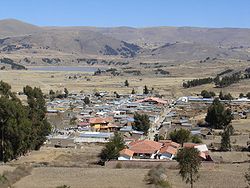Municipio Vacas
| Municipio Vacas | ||
|---|---|---|
 Vacas and two neighboring lakes |
||
| Basic data
|
||
| Population (state) - population density |
8940 inhabitants (2012 census) 27 inhabitants / km² |
|
| Telephone code | (+591) 4 | |
| surface | 334 km² | |
| height | 3420 m | |
| Coordinates | 17 ° 36 ′ S , 65 ° 36 ′ W | |
|
|
||
| politics
|
||
| Department | Cochabamba | |
| province | Arani Province | |
| Central place | Vacas | |
| mayor | Teófilo Vásquez Santos | |
 Vacas |
||
| climate | ||
 Climate diagram Vacas |
||
The Municipio Vacas is a district in the department of Cochabamba in the South American Andean state of Bolivia and was founded on October 15, 1986. Its inhabitants call themselves vaqueños or vaqueñas .
Location in the vicinity
The Municipio Vacas is one of two Municipios of the Province of Arani and is located in the eastern part of the Province. It borders the Municipio Arani to the west, the Mizque province to the south, the Carrasco province to the east , and the Tiraque province to the north .
The Municipio Vacas has an area of 334 km² and comprises 87 villages, the largest settlement in the center of the Municipio is Vacas with 757 inhabitants. ( 2012 )
geography
The municipality comprises a high basin without drainage and the surrounding ridges in the north-western part of the Cordillera Oriental . The valley has an altitude of 3420 m and is dominated by three large lakes, the Lagunas ( lakes ) Parco Kocha, Acero Khocha and Juntutuyo. The ridges around the high basin reach heights of up to more than 4,200 m, the streams and rivers flowing from there into the valley enable productive agriculture.
The climate of the region is characterized by a typical time of day climate , in which the daily temperature fluctuations are more pronounced than the seasonal fluctuations. The annual average temperature is 12 ° C (see climate diagram), the temperatures in the winter months of June / July are just under 10 ° C and in November / December a little more than 14 ° C. The annual precipitation is 550 mm and reaches values of 100 to 120 mm in the summer months from December to February, while in the arid months from May to September hardly any precipitation falls.
population
The population of the Municipio Vacas has decreased by about a tenth over the past two decades:
| year | Residents | source |
|---|---|---|
| 1992 | 10.172 | census |
| 2001 | 12,511 | census |
| 2012 | 8,940 | census |
The population density of the municipality was 26.8 inhabitants / km² at the 2012 census, the proportion of the urban population is 0 percent.
The life expectancy of newborns in 2001 was 52.9 years.
The literacy rate among those over 19 is 61.6 percent, namely 80.2 percent for men and 45.5 percent for women (2001) .
politics
Results of the elections for the municipal council ( concejales del municipio ) in the regional elections on April 4, 2010:
| electoral legitimate |
electoral participation |
valid votes | MAS-IPSP | MSM | MNR | ||
|---|---|---|---|---|---|---|---|
| 4,655 | 4.125 | 3,036 | 2.140 | 864 | 32 | ||
| 88.6% | 73.6% | 70.5% | 28.5% | 1.1% |
structure
The municipality consists of only one canton ( cantón ):
- 03-0502-01 Canton of Vacas
Localities in the Municipio Vacas
- Canton of Vacas
- Vacas 757 pop - Chaulla Mayu 514 pop
Individual evidence
- ↑ Estadísticas e Indicadores Sociodemográficos Productivos y Financieros por Municipio (INE) 2005
- ^ INE - Instituto Nacional de Estadística Bolivia 1992
- ^ INE - Instituto Nacional de Estadística Bolivia 2001
- ↑ INE - Instituto Nacional de Estadística Bolivia 2012 ( Memento of the original from March 4, 2016 in the Internet Archive ) Info: The archive link was inserted automatically and has not yet been checked. Please check the original and archive link according to the instructions and then remove this notice.
- ↑ Acta de computo Nacional Electoral Departamentales, Municipales y Regional 2010
Web links
- Municipio Vacas - Map
- Municipio Vacas - General Maps No. 30502
- Municipio Vacas - detailed map and population data (PDF; 302 kB) (Spanish)
- Departamento Cochabamba - social data of the municipalities (PDF; 7.58 MB) ( Spanish )
